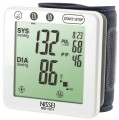Place of measurement
—
Shoulder. The classic version of the location of the blood pressure monitor cuff is on the shoulder of the left hand, ideally at the level of the heart. Shoulder arrangement can have tonometers of all types (see above).
—
Wrist. Wrist pressure measurement is found only among automatic models (see "Type"). The main advantage of such models is compactness. On the other hand, they are not recommended for the elderly, and many models are unable to work correctly with arrhythmia or a weak pulse — this point should be clarified separately when buying a device.
Power source
Type of power source of the blood pressure monitor. Power is required only for automatic and semi-automatic models (see "Type") — mechanical ones work solely due to the muscular strength of the user.
—
Batteries. The blood pressure monitor is powered by replaceable batteries that have a standard size — for example, AA. Such devices are autonomous, because they do not require a mains connection, and batteries are purchased without problems and are easy to change, unlike
built-in batteries (see below). On the other hand, batteries are usually not included in the package, and you have to buy them regularly, which is associated with corresponding expenses. An alternative is to buy the elements in the form of rechargeable batteries; they are quite expensive, however, having paid once for batteries and a charger, you no longer have to spend money on energy sources. Anyway, all blood pressure monitors with measurement on the wrist (see "Measuring place"), as well as some models of "shoulder" models, are powered by batteries.
— Batteries/mains. These blood pressure monitors offer dual power options, allowing them to operate on both replaceable batteries and a 230 V
network. This versatility enables battery usage in remote locations and the convenience of plugging into the network in more conventional settings to conserve battery life. However, the use of the net
...work requires a power source and adds bulk to the complete set. As a result, this type of power supply is exclusive to blood pressure monitors with measurements on the upper arm.
— Battery. These blood pressure monitors are powered by a proprietary, non-standard battery that is often non-removable. Similar to standard batteries, these power sources provide autonomy, allowing the device to function without nearby outlets. However, recharging the exhausted battery requires an electric source, typically an outlet, and the process is time-consuming. As a result, this power supply type is not widely adopted in blood pressure monitors and is primarily found in compact models where the use of standard batteries is technically impractical.Batteries
The type of batteries used in blood pressure monitors.
— AA. One of the most common types of batteries today. Voltage — 1.5 V. One of the main advantages of this type of power supply is availability:
AA batteries are sold almost everywhere where any batteries are sold at all.
— AAA. A kind of reduced analogue of AA batteries (see above) with the same operating voltage of 1.5 V.
AAA batteries are also very common, and the dimensions allow them to be used in more compact devices.
Cuff dimensions
The cuff's applicable range includes both the minimum and
maximum circumferences of the upper arm or wrist (see "Place of measurement"). Modern blood pressure monitors typically feature cuffs suitable for individuals with average physique, covering the majority of adult patients. However, for specialized cases, such as monitoring a child or someone with a larger bicep circumference, it is advisable to measure the arm circumference and compare it with the specified cuff sizes.
—
Small. The small cuffs are designed for a shoulder girth of 17-22 cm.
—
Standard. Standard cuffs cover a shoulder girth of 22-32 cm.
—
Oversized. Oversized cuffs have a girth of 22-36 cm.
—
Universal. Cuffs for both thin and large people. Universal cuffs provide a shoulder girth of 22-42 cm.
—
Large. Large cuffs with a girth of 33-46 cm are suitable for a full arm or a muscular shoulder of a conditional bodybuilder.
In box
—
Additional cuff. The blood pressure monitor set includes two cuffs, main and auxiliary, which differ from each other only in standard size. Usually, the auxiliary cuff has a longer length. For example, if the length of the main cuff is 22-36 cm, then the auxiliary cuff will be one size larger, that is, 30-42 cm. An additional larger cuff allows you to expand the circle of users of the blood pressure monitor.
—
Power source. Blood pressure monitors with a power supply option can operate using a 230 V household power supply, eliminating the need for frequent battery replacements. Interestingly, many of these monitors also come equipped with batteries, providing users flexibility in choosing the power source for the measuring device.
—
Cover/case. The blood pressure monitor comes with a dedicated bag for convenient storage and transportation of all its components. Depending on the tonometer's configuration, the case can accommodate the device, primary and auxiliary cuffs, a stethoscope, spare batteries, a power supply, and instructions. Some cases even include an extra compartment for storing medications. Typically, the tonometer bag is soft.
— Batteries. The blood pressure monitor operates on replaceable batteries, commonly using AA or AAA batteries. This battery-powered design makes the device self-contained, allowing its use in remo
...te locations or while traveling without access to a household electrical outlet. However, a drawback of battery-powered blood pressure monitors is the requirement for regular battery replacement or recharging.
